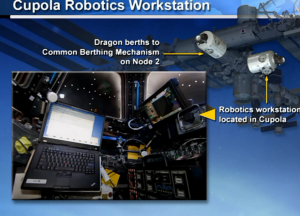Training for the worst
Practicing emergencies is necessary so I accept that the volunteer fire department near our home at Hochstadt runs their siren in the evening, even though it excites our 3-year-old daughter just before bedtime. We also need to practice emergencies on the International Space Station in space you cannot phone highly-trained rescue workers to come to the rescue. Astronauts must be able to fend for themselves, extinguish a fire and protect themselves from any fumes. Even radio contact with experts in control centers cannot be assumed to work in a worst-case scenario.
In today’s emergency exercise the control centres and astronauts worked together on a so-called On-Board Training or simply OBT. We had “stage directions” that defined for example that a leak would appear in the Japanese Kibo module through which air would escape.
The alarm sounded on the Space Station with its penetrating noise and the computer screens of our Flight Controller filled up with numerous error messages, proving that the International Space Station had configured itself in emergency mode. The astronauts onboard reported shortly afterwards to Mission Control Houston with the news that they had a pressure drop on the Space Station to contend with. All radio communication between crew and flight controllers began with the words “For the workout exercise:” to ensure that everybody knew it was not a real emergency, but an exercise.
The flight director in Houston declared a “Space Craft Emergency” – of preceded by “for the training exercise”. Sinje Steffen of the STRATOS team at the Columbus Control Centre checked whether Columbus was automatically reconfigured for this Rapid Depress scenario.
The astronauts convened in the meantime 350 km above close to their Soyuz spacecraft. Since the Russian capsules are the Station’s lifeboats, each astronaut has a well-defined place there. They are usually the first assembly point of crew in an emergency. Once there, they decide together on how to proceed based on the scheme “Warning – Gather – Fight”. In our emergency script scenario, the astronauts had about five hours until critical low pressure (designated as T.Res) would be reached – time enough to try to find the leaking module and possibly stop the International Space Station from ‘bleeding out’.
The astronauts followed the well-defined sequence to close various hatches to measure on which side the pressure dropped further. Slowly they were able to find their way closer and closer to the actual leak.
Columbus Flight Director Katja Leuoth and her team was busy keeping up with the falling pressure values: a long list of minimum air pressure certification values exist for all Columbus components – each of these elements had to be switched off before their critical pressure was reached. Today’s commands were “for the training exercise”, so actual commands were not issued and power was not actually switched-off…
The rapid pressure-drop (rapid depress) is one of three major emergency scenarios that are defined for the International Space Station.
Depending on the size of the leak, there are various ways to “clog the hole”: from an oversized bicycle-patch to a plasticine-like material. All sealing is done of course from inside the space station – and is easy: Compared to the vacuum of space the pressure inside the ISS is considerable higher and pushes any seal onto the leak – a clear advantage compared to repairing a bicycle inner tube…
Thomas Uhlig, Columbus Control Centre
21/04/2015





